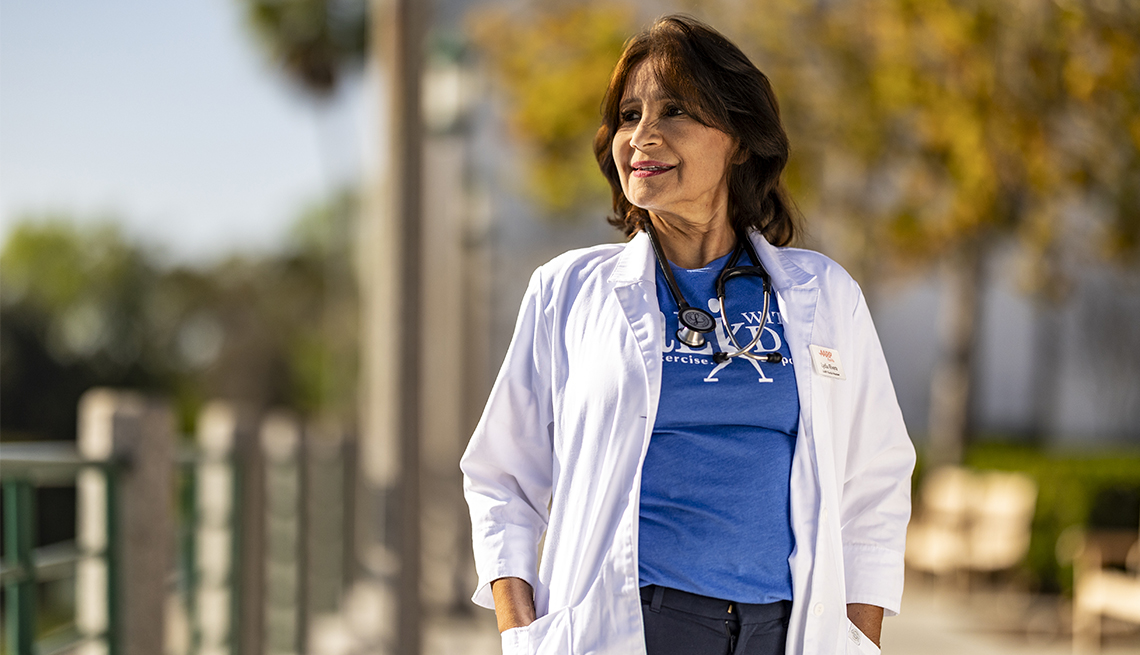AARP Hearing Center

Walking has been a daily habit for Lydia Rivera since she was a young girl growing up in Puerto Rico, where she traipsed nearly 5 miles to school every day.
Today, Rivera, 66, walks 4 to 6 miles a day near her home in Celebration, south of Orlando. A retired nurse practitioner, she knows regular physical activity is good for both her physical and mental health.
“The day that I don’t walk, I don’t feel [like] myself,” Rivera says.
Rivera is now sharing her love of walking—and her medical expertise—with others in her community through a new Walk with a Doc program serving Osceola County. AARP and Walk with a Doc, a nonprofit, have joined forces to offer the free program, led by health care professionals, in locations around the country.
Participants join Rivera in Kissimmee on the second Monday of every month as she speaks briefly about a topic such as nutrition or brain health. Then the group walks 1 to 3 miles in a local park. Walkers have the opportunity to speak to Rivera in English or Spanish and ask questions as they walk together.
It’s one of three AARP Walk with a Doc programs in the state. The others are in Tampa and Miramar.
AARP member Ovetta Williams, 80, says she has the Tampa walk “locked” on her calendar.
“Those talks remind me about the importance of being healthy,” says Williams, a retired schoolteacher. “They help me get back on track.”
New research has found that walking about 4,000 steps a day, or about 2 miles, can reduce your risk of dying of any cause. The risk of dying of cardiovascular disease or other causes continues to decrease the more you walk.
Walking—and talking
Rivera’s daughter, Yazmin Alfonso, is associate state director of outreach for AARP Orlando. She launched the Walk with a Doc program in Osceola County to help promote physical activity and give the area’s older adults an opportunity to ask health questions in a casual setting.
Alfonso recruited her mom to be the health professional for the walk; she knew Rivera—an AARP volunteer who worked as a nurse practitioner at the U.S. Department of Veterans Affairs for 35 years before retiring eight years ago—would be a natural for it. Alfonso also wanted to ensure the event would appeal to the area’s growing Hispanic population. Nearly 57 percent of Osceola County’s residents are Hispanic, according to U.S. Census Bureau estimates.
Studies suggest Hispanic adults in the U.S. are less likely than those of other racial and ethnic groups to see a doctor for medical concerns. Lack of insurance, language barriers and immigration status all play a role.
Rivera has since recruited her friend Maria Roldan—another bilingual nurse practitioner—to help her lead the walks. When they both attend, one does the health presentation in Spanish and the other does it in English. Then they are both available to answer questions as they walk.

Rivera says one of the most valuable parts of the program is the friendships that can form. She notes that loneliness has been linked to cognitive decline and a shorter lifespan.
The first AARP Walk with a Doc program in Florida launched in Tampa in 2022. Its monthly events attract between 25 and 50 participants, says Michelle Cyr, senior associate state director of outreach for AARP Tampa Bay. Cyr says the feedback has been overwhelmingly positive.
One regular attendee shared that she had lost more than 40 pounds and that her blood pressure and cholesterol levels had improved, she says.
“Most participants come back month after month, bringing friends and family,” Cyr says.
To learn more about Walk with a Doc, go to walkwithadoc.org
Michelle Crouch is a North Carolina–based journalist who covers health care and consumer issues. She has written for the Bulletin for 10 years.
More on fitness and wellness































































